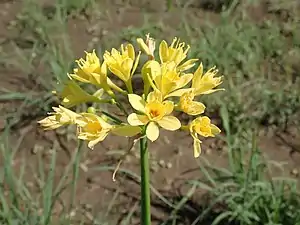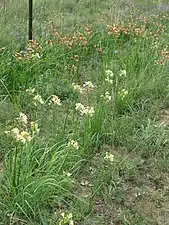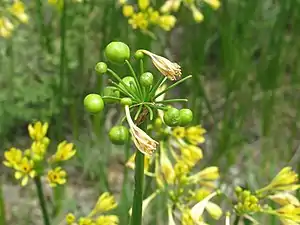Calostemma purpureum
Calostemma purpureum, the garland lily, is a long-lived perennial flowering plant that is native to South Australia, Victoria and New South Wales. Flowers may be cream, yellow, pink or purple.[2] Related to the common daffodil, garland lilies were once common in large colonies in grassy areas, in particular the plain on which the city of Adelaide now stands. Due to urbanisation and grazing, the garland lily is now rare, only occurring in small pockets in parks on the outskirts of the city.[3]
| Calostemma purpureum | |
|---|---|
 | |
| Scientific classification | |
| Kingdom: | Plantae |
| Clade: | Tracheophytes |
| Clade: | Angiosperms |
| Clade: | Monocots |
| Order: | Asparagales |
| Family: | Amaryllidaceae |
| Subfamily: | Amaryllidoideae |
| Genus: | Calostemma |
| Species: | C. purpureum |
| Binomial name | |
| Calostemma purpureum | |
 | |
| Occurrence data from AVH | |
| Synonyms | |
|
Calostemma lutea | |
Leaves form from the bulb during winter, and die off during spring. The plant flowers during summer when there are no leaves. Calostemma purpureum bursts into flower in the midst of the heat of an Australian summer, when most other plants are not flowering. The flowers are purple-pink in colour forming in an umbel of 5-10 showy flowers. They appear on a stalk around 30 centimetres long. The flowers are replaced in autumn by clusters of large, berry-like seeds. The seeds may germinate while still on the plant. They germinate very readily but it may take three or four years before the new plant first flowers.[4]
Image gallery
 Flower head
Flower head Large colony near Gunnedah, NSW
Large colony near Gunnedah, NSW Differently coloured flowers
Differently coloured flowers Bicoloured flowers
Bicoloured flowers Field of mixed colours
Field of mixed colours Developing fruit
Developing fruit
References
- "Calostemma purpureum". Australian Plant Name Index (APNI), IBIS database. Centre for Plant Biodiversity Research, Australian Government, Canberra. Retrieved 23 December 2011.
- "Calostemma purpureum". PlantNET - New South Wales Flora Online. Royal Botanic Gardens & Domain Trust, Sydney Australia. Retrieved 26 February 2020.
- "The Native Plants of Adelaide". Department for Environment and Heritage. Archived from the original on 15 March 2011. Retrieved 21 March 2011.
- "Plants of the Adelaide plains and hills". Library of South Australia. Retrieved 21 March 2011.
External links
 Data related to Calostemma purpureum at Wikispecies
Data related to Calostemma purpureum at Wikispecies Media related to Calostemma purpureum at Wikimedia Commons
Media related to Calostemma purpureum at Wikimedia Commons